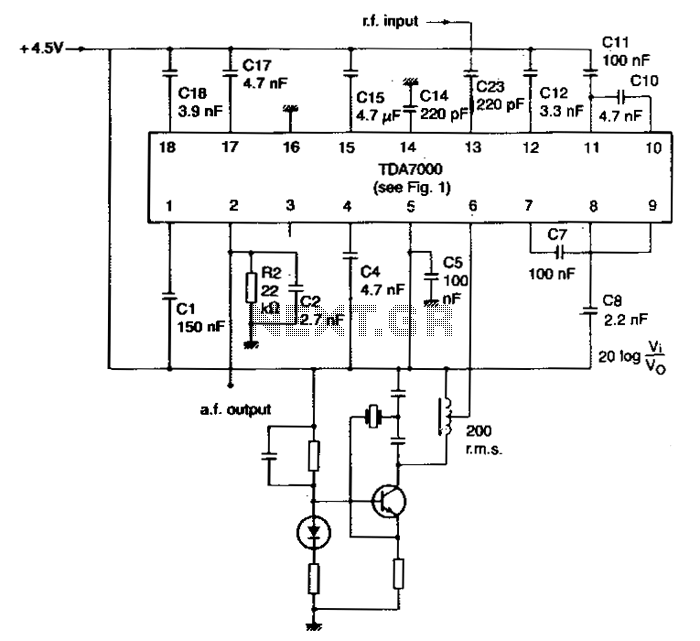
Narrow-band-fm-receiver

The local oscillator is controlled by a crystal, and the intermediate frequency (i-f) swing is minimally compressed. To prevent significant distortion of the demodulated audio signal, the deviation of the transmitted carrier frequency due to modulation must be limited. The component values yield an i-f of 4.5 kHz and an i-f bandwidth of 5 kHz. If the i-f is multiplied by a factor of N, the values of capacitors C17 and C18 in the all-pass filters, along with the values of filter capacitors C7, C8, C10, C11, and C12, must be scaled by 1/N. For enhanced i-f selectivity and improved adjacent channel attenuation, second-order networks can be employed instead of C10 and C11.
The described circuit utilizes a crystal-controlled local oscillator to maintain frequency stability, which is crucial for effective modulation and demodulation processes. The intermediate frequency (i-f) is set at 4.5 kHz, with a bandwidth of 5 kHz, allowing for adequate signal processing while minimizing the risk of distortion. The modulation process introduces a deviation in the carrier frequency; thus, careful management of this deviation is essential to preserve the integrity of the audio signal after demodulation.
In scenarios where the i-f is multiplied by a factor of N, adjustments to the capacitors are necessary to maintain circuit performance. Specifically, capacitors C17 and C18 in the all-pass filters, as well as filter capacitors C7, C8, C10, C11, and C12, must be resized according to the factor of 1/N. This scaling ensures that the frequency response of the circuit remains consistent with the new i-f.
To enhance selectivity and achieve better adjacent channel attenuation, the circuit can incorporate second-order filter networks in place of the standard first-order filters represented by capacitors C10 and C11. Second-order networks provide sharper roll-off characteristics, improving the circuit's ability to reject unwanted signals from adjacent channels, thus enhancing overall system performance and audio clarity. This design consideration is critical in applications where signal integrity and clarity are paramount.The local oscillator is crystal-controlled and the i-f swing is hardly compressed. The deviation of the transmitted carrier frequency, because of modulation, must therefore be limited to prevent severe distortion of the demodulated audio signal. The component values result in an i-f of 4.5 kHz and an i-f bandwidth of 5kHz. If the i-f is multiplied ll"f N, the values of capacitors Cl7 and Cl8 in the all-pass filters, and the values of illter capacitors C7, CS, ClO, Cll, and Cl2 must be multiplied by 1/N.
For improved i-f selectivity to achieve greater adjacent channel attenuation, second-order networks can be used in place of ClO and Cll. 🔗 External reference
The described circuit utilizes a crystal-controlled local oscillator to maintain frequency stability, which is crucial for effective modulation and demodulation processes. The intermediate frequency (i-f) is set at 4.5 kHz, with a bandwidth of 5 kHz, allowing for adequate signal processing while minimizing the risk of distortion. The modulation process introduces a deviation in the carrier frequency; thus, careful management of this deviation is essential to preserve the integrity of the audio signal after demodulation.
In scenarios where the i-f is multiplied by a factor of N, adjustments to the capacitors are necessary to maintain circuit performance. Specifically, capacitors C17 and C18 in the all-pass filters, as well as filter capacitors C7, C8, C10, C11, and C12, must be resized according to the factor of 1/N. This scaling ensures that the frequency response of the circuit remains consistent with the new i-f.
To enhance selectivity and achieve better adjacent channel attenuation, the circuit can incorporate second-order filter networks in place of the standard first-order filters represented by capacitors C10 and C11. Second-order networks provide sharper roll-off characteristics, improving the circuit's ability to reject unwanted signals from adjacent channels, thus enhancing overall system performance and audio clarity. This design consideration is critical in applications where signal integrity and clarity are paramount.The local oscillator is crystal-controlled and the i-f swing is hardly compressed. The deviation of the transmitted carrier frequency, because of modulation, must therefore be limited to prevent severe distortion of the demodulated audio signal. The component values result in an i-f of 4.5 kHz and an i-f bandwidth of 5kHz. If the i-f is multiplied ll"f N, the values of capacitors Cl7 and Cl8 in the all-pass filters, and the values of illter capacitors C7, CS, ClO, Cll, and Cl2 must be multiplied by 1/N.
For improved i-f selectivity to achieve greater adjacent channel attenuation, second-order networks can be used in place of ClO and Cll. 🔗 External reference